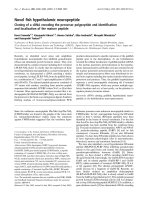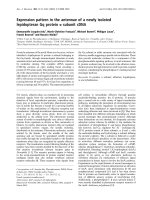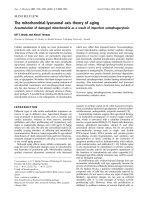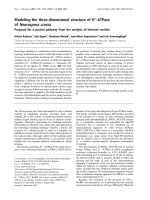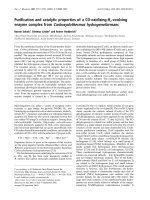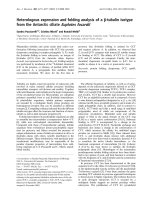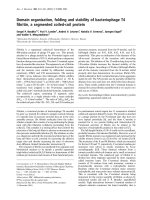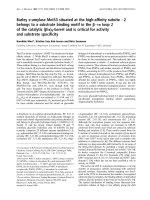Báo cáo y học: " INCANT: a transnational randomized trial of Multidimensional Family Therapy versus treatment as usual for adolescents with cannabis use disorder" pptx
Bạn đang xem bản rút gọn của tài liệu. Xem và tải ngay bản đầy đủ của tài liệu tại đây (420.93 KB, 8 trang )
Rigter et al. BMC Psychiatry 2010, 10:28
/>Open Access
STUDY PROTOCOL
BioMed Central
© 2010 Rigter et al; licensee BioMed Central Ltd. This is an Open Access article distributed under the terms of the Creative Commons
Attribution License ( which permits unrestricted use, distribution, and reproduction in
any medium, provided the original work is properly cited.
Study protocol
INCANT: a transnational randomized trial of
Multidimensional Family Therapy versus treatment
as usual for adolescents with cannabis use disorder
Henk Rigter*
1,2
, Isidore Pelc
3
, Peter Tossmann
4
, Olivier Phan
5
, Esther Grichting
6
, Vincent Hendriks
7
and Cindy Rowe
8
Abstract
Background: In 2003, the governments of Belgium, France, Germany, the Netherlands and Switzerland agreed that
there was a need in Europe for a treatment programme for adolescents with cannabis use disorders and other
behavioural problems. Based on an exhaustive literature review of evidence-based treatments and an international
experts meeting, Multidimensional Family Therapy (MDFT) was selected for a pilot study first, which was successful,
and then for a joint, transnational randomized controlled trial named INCANT (INternational CAnnabis Need for
Treatment).
Methods/design: INCANT is a randomized controlled trial (RCT) with an open-label, parallel group design. This study
compares MDFT with treatment as usual (TAU) at and across sites in Brussels, Berlin, Paris, The Hague and Geneva.
Assessments are at baseline and at 3, 6, 9 and 12 months after randomization. A minimum of 450 cases in total is
required; sites will recruit 60 cases each in Belgium and Switzerland, and a maximum of 120 each in France, Germany
and the Netherlands.
Eligible for INCANT are adolescents from 13 through 18 years of age with a cannabis use disorder (dependence or
abuse), with at least one parent willing to take part in the treatment. Randomization is concealed to, and therefore
beyond control by, the researcher/site requesting it. Randomization is stratified as to gender, age and level of cannabis
consumption.
Assessments focus on substance use; mental function; behavioural problems; and functioning regarding family, school,
peers and leisure time.
For outcome analyses, the study will use state of the art latent growth curve modelling techniques, including all
randomized participants according to the intention-to-treat principle.
INCANT has been approved by the appropriate ethical boards in Belgium, France, Germany, the Netherlands,
Switzerland, and the University of Miami Miller School of Medicine. INCANT is funded by the (federal) Ministries of
Health of Belgium, Germany, the Netherlands, Switzerland, and by MILDT: the Mission Interministerielle de Lutte Contra
la Drogue et de Toximanie, France.
Discussion: Until recently, cannabis use disorders in adolescents were not viewed in Europe as requiring treatment,
and the co-occurrence of such disorders with other mental and behavioural problems was underestimated. This has
changed now.
Initially, there was doubt that a RCT would be feasible in treatment sectors and countries with no experience in this
type of study. INCANT has proven that such doubts are unjustified. Governments and treatment sites from the five
participating countries agreed on a sound study protocol, and the INCANT trial is now underway as planned.
Trial registration: ISRCTN51014277
Rigter et al. BMC Psychiatry 2010, 10:28
/>Page 2 of 8
Background
In 1999, the (junior) Ministers of Health of five Western
European countries - Belgium, France, Germany, the
Netherlands, and Switzerland - concluded that their
countries were fighting each other over cannabis policies
without sufficient scientific evidence to support any view.
They agreed to combine scientific efforts. Based on a sys-
tematic literature review and the recommendations of an
international group of experts [1], the Five-Countries
Action Plan for Cannabis Research was adopted in April
2003. It stressed the need of a transnational trial to test an
outpatient treatment of cannabis use disorder in youth
who may have other problems as well. The Plan acknowl-
edged that adolescents are sensitive to developing canna-
bis use disorder, which is not easily overcome without
treatment [2].
The treatment selected in the Action Plan was Multidi-
mensional Family Therapy (MDFT), developed since
1985 by Liddle and co-workers at the Center for Treat-
ment Research on Adolescent Drug Abuse (CTRADA),
University of Miami Miller School of Medicine [2].
MDFT is a family based outpatient treatment programme
for adolescent problem behaviour. The term 'multidimen-
sional' reflects the assumption that each major domain in
the life of an adolescent may contribute to the incidence
and persistence of behavioural problems (through risk
factors) and may help in resolving such problems
(through protective factors). The life domains include the
youth itself, parent, family, friends and peers, school and
work, and leisure time. The therapist conducts therapy
sessions - with multiple therapeutic alliances: with both
the adolescent and the parents -, but also sets out to
improve life domain conditions for the adolescent and the
family in an outreaching and pragmatic fashion. MDFT
views family functioning as instrumental in creating new,
developmentally adaptive lifestyle alternatives for the
adolescent. Skills training includes substance use relapse
prevention, family communication, and parenting.
MDFT has been tested with success in different adoles-
cent populations, doses and treatment delivery settings
[3,4].
Once it had been decided that a trial was called for,
implementation hurdles had to be overcome and confi-
dence in the feasibility of a trial had to be boosted.
Although the existence of cannabis use disorder among
adolescents had been accepted at the time INCANT was
planned, there were quite a few policy makers and thera-
pists who thought that youth with such a disorder, and
their families, would not be interested in seeking help, let
alone in joining a trial. It was feared that INCANT would
fail in recruiting enough subjects, because a (real-world)
RCT was still exotic and controversial in Western Euro-
pean youth care at the time. Also, there was concern that
a treatment like MDFT, because it is manual-based and
time-limited, would stand no chance in countries such as
France with a dominant psycho-analytic treatment tradi-
tion. Similarly, MDFT was thought to meet opposition in
Germany, where treatment of substance abusing adoles-
cents often lasted for more than 1 year. Further, therapists
from some of the participating countries - such as Swit-
zerland - believed that mandatory urine tests of alcohol
and drug use, which are common practice in American
addiction care and a recommended part of MDFT, would
not be acceptable to European adolescents.
In view of all this, the five countries carried out a pilot
study first to examine the feasibility of a trial of MDFT in
Western Europe. Therapists from all participating coun-
tries were successfully trained to adequate levels of
MDFT adherence and competence as specified in the
treatment manual [5]. The potential for recruiting cases
for treatment and for study purposes appeared to be
promising, and substance urine tests were accepted by
virtually all families considered in the pilot study. MDFT
could be properly applied, despite variation between the
five European countries in mainstream theoretical treat-
ment orientation, personnel requirements, and reim-
bursement policies.
Because of the generally positive results of this pilot [6],
the countries had a protocol prepared for a main study,
named INCANT (INternational CAnnabis Need of
Treatment). INCANT was to be organized on a transna-
tional basis, with input from all participating countries
and with the prospect of helping to create a joint Euro-
pean treatment research infrastructure.
We here report on the design of INCANT.
Methods/Design
Design
INCANT is a multicentre phase III(b) randomized con-
trolled trial with an open-label, parallel group design.
This study compares MDFT with treatment as usual
(TAU) at and across sites in Brussels, Berlin, Paris, The
Hague and Geneva. Assessments are at baseline (immedi-
ately before randomization) and at 3, 6, 9 and 12 months
after randomization.
Approval
INCANT has been approved by the Ethical Board of
Brugmann University Hospital (Belgium), the committee
for public law issues of the Chamber of Psychological
Psychotherapists and Child and Adolescent Therapists in
the state of Berlin (Germany), the Hotel-Dieu Committee
for the Protection of Human Subjects in Biomedical
Research (CCPPRB; France), the medical-ethical com-
mittee for research in mental health care settings
(METiGG kamer Noord; the Netherlands), the Ethical
Board for Clinical and Outpatient Research (Medical
* Correspondence:
1
Department of Public Health, Erasmus MC, Rotterdam, the Netherlands
Full list of author information is available at the end of the article
Rigter et al. BMC Psychiatry 2010, 10:28
/>Page 3 of 8
Association of the Geneva Canton; Switzerland), and by
the Institutional Review Board of the University of Miami
Miller School of Medicine. These boards monitor the
progress of the study in terms of recruitment, drop-out
and the possible incidence of untoward events.
Treatment centres
In 2003, government representatives from Belgium,
France, Germany, the Netherlands and Switzerland nom-
inated candidate youth outpatient treatment centres for
taking part in the pilot study preceding INCANT. The
project leader (HR) and CTRADA staff from Miami vis-
ited the nominated centres. They selected the depart-
ment of psychiatry of Brugmann University Hospital in
Brussels; Therapieladen in Berlin; Centre Emergence in
Paris with suburban CEDAT (Conseils Aide et Action
contre le Toximanie) sub-sites in Mantes la Jolie and St
Germain en Laye; and the twinning sites of Parnassia Bri-
jder (Mistral, youth addiction care) and De Jutters
(Palmhuis, youth forensic care) in The Hague. All these
sites did well in the pilot study [6] and have joined the
INCANT trial. In Switzerland, the pilot study sites in
Zurich, Basle and Bern were replaced by Phénix (Geneva)
for the actual trial, as the potential for recruiting sub-
stance abusing adolescents was better there.
Participants
Eligible for INCANT are adolescents of either sex, from
13 through 18 years of age, with a cannabis use disorder
(dependence or abuse), with at least one parent willing to
take part in the treatment. The word 'parent' denotes any
legal representative of the adolescent (including step or
foster parent, or guardian). We use the singular 'parent'
here, also including the plural 'parents'. Adolescent and
parent together are referred to as a 'case'.
Adolescents are ineligible if unable to understand - IQ
lower than 70 - the local language, unable to attend out-
patient sessions, or if suffering from a mental or behav-
ioural disorder requiring inpatient treatment. Parents
(and therefore cases) are ineligible if unable to under-
stand the local language or attend sessions.
Informed consent for study participation is obtained
from both adolescent and parent.
Sample size
We carried out power calculations to determine the num-
ber of subjects needed to establish treatment effects on
substance use measures within and across sites. To this
end, we applied Monte Carlo simulation techniques with
latent growth curve models [7]. A large number of sam-
ples were drawn, systematically varying effect size esti-
mates, and a model was constructed for each sample.
Each simulation tested a linear growth model for contin-
uous outcomes with four time points (0, 6, 9 and 12
months), representing the four major INCANT assess-
ment points. The result of interest was the regression
coefficient between a dichotomous covariate represent-
ing treatment condition and the latent slope representing
change in substance use over time.
In previous trials of MDFT [[4], for review] the size of
the comparative treatment effect - the extent in which
MDFT outperformed active control treatments - has gen-
erally been in the moderate to high range [8] of d = 0.6 or
above. Conservatively assuming small effects, the models
we generated predicted that power would be above 0.9 if
the total cross-site sample consisted of 450 or more cases.
For individual site analyses, assuming an effect size of 0.7,
a sample of 100 per site would be needed to achieve
power of 0.82.
We set the recruitment target at 480 cases. The sites in
Germany, France and the Netherlands aim to recruit a
maximum of 120 cases each. Because of budget limita-
tions, Belgium and Switzerland settle for 60 cases each,
with the intention to contribute to the cross-site statisti-
cal analyses.
Recruitment
There are two recruitment annex baseline measurement
meetings. The first session, generally with the adolescent
and parent together, is carried out by the clinical supervi-
sor of the treatment centre, except in Brussels where the
(clinically trained) INCANT researcher serves as the
'front office'. In this session, all eligibility criteria are
checked, including the adolescent's cannabis use, but as
yet no diagnosis of cannabis use disorder is set. INCANT
is explained, and youth and parent are given study infor-
mation materials and informed consent forms to read
before coming back for the second recruitment session
generally held a few days later.
In this second meeting, all (remaining) baseline mea-
surements are conducted, separately for youth and par-
ent. If eligible - diagnosis of cannabis use disorder
confirmed -, youth and parent are both invited to sign the
respective informed consent form.
Central database
Each site has one or two researchers authorized to access
their own site's internet based location - part of the Eras-
mus MC managed INCANT central database (open
source MySCL) -, but not the locations of the other sites.
Only the Erasmus MC database manager has full access
to all locations and is mandated to change inputted data if
so instructed by the project leader (HR) on behalf of the
international committee overseeing the design and exe-
cution of the trial, viz., the INCANT Study Team (IST).
When inputting data into the database, each case is
identified by a code assigned by the database at the time
randomization was requested. The INCANT privacy pol-
icy ensures that each researcher locally stores person
identifying data in such a way that they are blocked from
access by others and not become part of the database.
Rigter et al. BMC Psychiatry 2010, 10:28
/>Page 4 of 8
Each questionnaire or interview, per assessment point,
has its own file in the database, formatted using PHP Sur-
veyor version 1.0.
Randomization
Randomization takes place right after having obtained
informed consent.
In Belgium, France, Germany and Switzerland, we
stratified the study sample using three dichotomous vari-
ables (gender; age [13-14 years vs. 15-18 years]; and level
of cannabis use in the past 90 days [74 or fewer days of
cannabis consumption vs. 75 or more]). In the Nether-
lands, we added the stratification variable 'ethnicity' (ado-
lescents classified according to national census
definitions as being from indigenous or immigrant
descent). In total, across sites and sub-sites, there are 72
strata. For each stratum, the database computer gener-
ated 50 independent randomisations. For each site except
one in France, we have two randomisation arms (MDFT
vs. TAU) and we use block randomisation with randomly
permuted blocks of 2 or 4 cases. For one site in France,
where there are three randomisation arms (MDFT, TAU
and TAU-e; see below), we use blocks of 3 or 6 cases.
Randomization is concealed. A researcher enters new
cases into the database, through her site's internet loca-
tion, as soon as informed consent has been obtained, pro-
viding data on the stratification variables. Case code and
randomization outcome are given automatically and right
away, enabling the researcher to inform the family and to
schedule appointments with the proper therapist without
delay.
Blinding
Given the nature of the interventions, local researchers
cannot be blinded as to the treatment delivered. Central
research staff will be unaware of treatment condition
when carrying out analyses to assess outcomes.
Experimental intervention (MDFT)
MDFT is delivered by individual therapists who are part
of teams of 3 - 5 CTRADA certified therapists, with one
of them additionally serving as team supervisor.
MDFT is carried out according to the MDFT treatment
manual />.
MDFT lasts 5 to 7 months, depending on the severity of
the case. On average, sessions are scheduled twice a week
- in roughly equal proportion to be held with the adoles-
cent, parent and family (adolescent + parent) respectively,
and additionally with representatives of other systems
(school, work, friends, agencies) present. Sessions can
take place at the office, but also at the family's home or
any other convenient location. Scheduling sessions is not
limited to regular office hours. Each team meets once a
week to discuss cases and issues.
Control condition
INCANT compares MDFT with treatment as usual
(TAU). TAU is carried out by the same treatment centres
offering MDFT, but procedurally separated to avoid 'con-
tamination' of therapists and participants between the
experimental and control conditions.
TAU varies between the participating countries, but
has in common motivational interviewing and elements
of cognitive-behavioural therapy (CBT) in addition to
more general individually-based substance abuse coun-
selling. TAU in Belgium, Germany and Switzerland is
characterized by a mixture of CBT and individual drug
counselling, and in the Netherlands by a cognitive-behav-
ioural approach tailored to adolescents (Leefstijltraining).
The Dutch TAU therapists have received formal training
in TAU for the purpose of the trial. In France, MDFT is
compared with TAU (a mix of CBT and individual coun-
selling methods as used in daily practice) and TAU-e
(TAU-explicit = idem, but then manualized). The French
TAU-e therapists have been trained in using the TAU-e
manual; the TAU therapists have not received special
training for INCANT. Below, French TAU and TAU-e are
jointly referred to as 'TAU'.
Across sites, we set minimal requirements for TAU.
The control treatment matches MDFT in total duration
of the therapy. MDFT and TAU do not differ in assess-
ments and in general procedures such as therapists work-
ing in a team; applying substance use urine tests;
communication with referral sources and authorities; and
occasional referral to additional treatments to deal with
psychiatric co-morbidity and medication. Furthermore,
MDFT and TAU do not differ in session duration; drug
education; and the way the adolescent is individually
trained in substance use relapse prevention, with empha-
sis put on coping with stress, managing anger, increasing
assertiveness in interpersonal contacts, and addressing
(negative) thoughts about substance use.
TAU sessions are individual (with the adolescent). Par-
ents may be seen alone or in groups, purely for reasons of
drug education and mutual support, but any element of
systems therapy involving the parent and other systems
into the treatment is excluded.
Monitoring of treatment integrity
In all INCANT conditions, the therapists are required to
submit treatment contact logs or data from the centre's
treatment register providing the same insight: number,
duration, spacing and composition of sessions (therapist
meeting whom). These data are used throughout the
study to ensure that all therapists meet the pre-set mini-
mum level of treatment intensity. In MDFT, these logs are
monitored by CTRADA (University of Miami) staff to
ensure fidelity to MDFT parameters of contact with ado-
lescent, parent, family, and external systems sessions.
Rigter et al. BMC Psychiatry 2010, 10:28
/>Page 5 of 8
Based on treatment adherence evaluation guidelines
[5], 25% of MDFT cases are selected for transcribing one
family session, which is translated in English to allow
CTRADA to rate these sessions for MDFT treatment
adherence with a validated 7-point Likert scale targeting
16 therapists' interventions crucial to MDFT [9].
Therapists
All MDFT (n = 25) and TAU therapists (n = 29) are expe-
rienced in treating adolescents with multiple problem
behaviour. MDFT therapists are similar to TAU thera-
pists with regard to age (MDFT vs. TAU across sites: 42
vs. 40 years of age) and gender (48% male in MDFT, and
35% in TAU).
CTRADA trained the sites' MDFT teams in 2004 -
2005, with plenary training weeks in Europe and Miami;
evaluation of MDFT family sessions and session logs;
bimonthly telephone consultation calls; and site visits by
CTRADA staff. Booster training was given in 2006 and
2007. TAU training in the Netherlands and TAU-e train-
ing in France were delivered locally by senior clinical staff
from the treatment centre (France) or by a CBT training
unit (the Netherlands).
Remuneration
The adolescents but not the parents are remunerated in
local currency, either by voucher or in cash, for complet-
ing follow-up assessments, for a total of € 60 - 70 accu-
mulated across all follow-up assessments. No
remuneration is given in Belgium and France, where this
would run counter to legal requirements.
Assessments
Assessments take place at baseline and at 3, 6, 9 and 12
months post-randomization, at the treatment centre, the
home of the family or any other convenient place. Addi-
tional information is gathered by phone or mail. Ques-
tionnaires are self-administered by the adolescent or
parent, or if required completed by a researcher, who has
been trained by INCANT project staff and is working
under the guidance of three Instruction Manuals (for
baseline, 3-months FU, and later FU, respectively; http://
incant.eu). Table 1 shows the questionnaires and inter-
views delivered.
Study hypotheses
INCANT addresses a number of research questions:
Primary outcomes
Does MDFT exceed TAU in reducing the use of cannabis
and the prevalence of (symptoms of) cannabis disorders?
We assume that adolescents assigned to MDFT will
decrease their use of cannabis more than adolescents in
TAU between baseline and 6-months follow-up assess-
ments. This treatment gain is expected to be maintained
better in MDFT than in TAU in the period between 6-
and 12-months follow-up.
Moreover, youth assigned to MDFT will be less likely to
meet diagnostic criteria of cannabis disorders between
baseline and the 12-months follow-up assessment than
TAU youth.
Secondary outcomes
An important secondary outcome is the extent in which
the treatments succeed in engaging and retaining cases
into the respective intervention programme. We assume
that MDFT will do better than TAU in this respect.
Further, we hypothesize that MDFT exceeds TAU in
attenuating established risk factors for persistence of can-
nabis disorders: other substance use, internalizing and
externalizing mental disorder symptoms, family dysfunc-
tion, school problems, delinquency. For each of the fac-
tors mentioned, a hypothesis has been formulated and
measures have been selected.
Finally, we examine the degree in which MDFT and
TAU are appreciated by adolescents and parents, assum-
ing that MDFT will receive higher satisfaction ratings
than TAU.
Measures
Table 1 gives an overview of the instruments - question-
naires and structured interviews - to be applied at base-
line and four follow-up assessment points, distinguishing
measures administered to youth and parent.
Background and demographic information
The Parent and Adolescent Interviews [9] have been tai-
lored to gather demographic data on gender, age and eth-
nicity, and on family composition, history of familial drug
use and mental health problems, adolescent substance
use history and court involvement, treatment history and
service utilization, school functioning, peer relationships,
and pastime activities.
Primary outcomes: cannabis use
Cannabis use and other substance use disorders are
assessed with the Adolescent Diagnostic Interview-Light
(ADI-Light; [10]). This brief structured, multi-axial inter-
view is based on DSM-IV criteria for substance use disor-
ders in adolescents. At baseline, an ADI-Light established
diagnosis of recent cannabis use disorder was required to
enrol the case into INCANT.
We measure the frequency of adolescents' cannabis use
with the Timeline Follow-Back method (TLFB; [11] as
adapted and validated for adolescents [12]. The TLFB
obtains retrospective reports of daily cannabis use for the
90-day period prior to each assessment, using a calendar
and other memory prompts to stimulate recall.
Adolescents' preoccupation with and motivation for
substance use are recorded with the Personal Involve-
ment with Chemicals Scale from the Personal Experi-
ences Inventory (PEI). The psychometric properties of
this scale are excellent. A reliability score of α = 0.97 has
been reported [13].
Rigter et al. BMC Psychiatry 2010, 10:28
/>Page 6 of 8
Secondary outcomes: adolescents' psychosocial functioning
We assess adolescents' internalizing, externalizing, and
psychotic symptoms with the Youth Self Report (YSR).
This instrument is reliable and valid across a variety of
studies, populations, and languages (including Dutch,
German and French) [14,15]. We also apply the 'parent
version' of the YSR, which is called CBCL (Child Behavior
Checklist). Like the YSR, the CBCL has excellent (test-
retest, internal consistency, inter-rater) reliability and
(construct, concurrent, discriminant) validity in various
languages [e.g., [14,16]].
Secondary outcomes: family functioning
Family conflict and cohesion are measured with the
respective sub-scales from the Family Environment Scale
(FES), a widely used and well validated self-report mea-
sure [17], completed by the teen. The FES has adequate
psychometric properties. The Conflict and Cohesion
parts have good reliability (α = 0.75 and α = 0.78, respec-
tively) [17,18].
Secondary outcomes: treatment satisfaction
At 6-months follow-up, corresponding to the end of a full
course of treatment, adolescents and parents each com-
Table 1: Measures used in INCANT at baseline and at four post-randomization follow-up points
Surveys Baseline Month 3 Month 6 Month 9 Month 12
Adolescent
Cannabis section,
ADI-Light
• •
Alcohol section,
ADI-Light
• •
Other drugs, ADI-
Light
• •
Urine analyses of
substance use
•••••
TLFB •••••
Adolescent
Interview
•••
Life Events • •
PEI • • • •
Cannabis section,
ADI-Light
• •
Alcohol section,
ADI-Light
• •
Other drugs, ADI-
Light
• •
FES • • • •
YSR•••
Treatment
satisfaction,
adolescent
•
Parent
Parent Interview•••
CBCL•••
Treatment
satisfaction,
parent
•
Abbreviations: ADI = Adolescent Diagnostic Interview, CBCL = Child Behavior Check List, FES = Family Environment Scale, PEI = Personal
Experience Inventory, YSR = Youth Self-Report.
Rigter et al. BMC Psychiatry 2010, 10:28
/>Page 7 of 8
plete the Satisfaction Scale, which measures satisfaction
with treatment received along four dimensions: (1) access
to and convenience of treatment arrangements, (2) ado-
lescent's treatment process and relationship with the
therapist, (3) parent and family services, and (4) global
satisfaction. These scales have adequate reliability and
validity [19].
Analyses
The analyses will be based on the intent-to-treat princi-
ple, such that all cases will be assessed at all time points
regardless of therapy and therapy dosage received.
We will pool the data from all subjects from all sites for
analyses with country/site as a covariate. If differences
between sites are statistically significant, within-site anal-
yses will be done for the topics concerned.
Most measures in the trial are repeated (Table 1). For
repeated measures we will apply both a mixed model for
repeated measurements and Latent Growth Curve Mod-
elling (LGM). LGM serves to model individual differ-
ences in change as measured by instruments such as the
TLFB and PEI. LGM has the advantage of charting indi-
vidual change trajectories [7] while producing unbiased
estimates when data are missing [20]. Change trajectories
will be evaluated across all assessment points.
The LGM models are statistically equivalent to random
coefficient regression models.
As for MDFT treatment adherence, we will use equiva-
lence testing procedures to compare the mean MDFT
adherence scores to benchmark values for therapists
trained in U.S based trials of MDFT, to see if they are
statistically equivalent. We will use an a priori equiva-
lence interval of +/- 20 percent. A 90% confidence inter-
val will be calculated around the mean difference
between the adherence scores in INCANT and the
benchmark values. If the values for the 90% confidence
interval fall within the a priori equivalence interval, the
scores are considered to be statistically equivalent [21].
To meet the challenges of data analyses, a statistical
workgroup has been formed consisting of specialists
from Erasmus MC, CTRADA, INSERM (France) and
Delphi (Germany). The workgroup will report to the
INCANT Study Team.
Discussion
There are differences in mainstream treatment philoso-
phy between the countries taking part in INCANT.
Thanks to a pilot study and intensive international con-
sultation and training, these differences eventually
appeared to be surmountable or at least not strong
enough to block the trial here reported. INCANT is
firmly underway, with steady enrolment of cases.
INCANT is more than a treatment trial. In a way, it is
also a social and cultural experiment. At first, European
officials thought that MDFT, as it originates from the
USA, might be at odds with European practices and tra-
ditions. However, while preparing for INCANT the dif-
ferences between European countries appeared to be
bigger than the difference between any of them and
Miami. Nevertheless, MDFT proved to be adaptable to
European treatment settings in all of the five countries,
such that procedures are mutually comparable (except for
referral source).
In some of our five countries, there was hardly any
experience, if at all, with conducting an RCT in youth
(addiction, mental, forensic) care. Making referral
authorities, treatment and funding agencies accept the
principle of randomization was seen as (almost) a bridge
too far. If INCANT yields any comparative treatment
effects remains to be seen, but INCANT did succeed in
making a trial happen in rather uncharted territory.
Abbreviations
ADI: Adolescent Diagnostic Interview; CBCL: Child Behavior Checklist; CBT: cog-
nitive-behavioural therapy; CTRADA: Center for Treatment Research on Adoles-
cent Drug Abuse; FES: Family Environment Scale; INCANT: International
Cannabis Need of Treatment study; IST: INCANT Study Team; MDFT: Multidi-
mensional Family Treatment; PEI: Personal Experiences Inventory; TAU: Treat-
ment As Usual; TAU-e: manualized TAU in France (e = 'explicit'); TLFB: Timeline
Follow-Back; YSR: Youth Self Report.
Competing interests
CR trains teams of therapists in MDFT as a consultant. All other authors declare
that they have no competing interests.
Authors' contributions
All authors were substantially involved in the conception of the study. HR and
CR designed and coordinated the overall study, whereas IP, PT, OP, VH and EG
did set up the study at the respective national sites. All authors are instrumen-
tal in collecting and interpreting the data. HR drafted the manuscript with the
assistance of CR. The other authors critically revised the text. All have approved
the present publication.
Acknowledgements
This research is part of a transnational effort to stimulate cannabis research,
jointly supported by the (federal) Ministries of Health of Belgium, Germany, the
Netherlands, Switzerland, and by MILDT: the Mission Interministerielle de Lutte
Contra la Drogue et de Toximanie, France. These agencies are funding INCANT
but have no influence on the design and the execution of the study, or on the
interpretation and reporting of its results.
We thank Howard Liddle and Gayle Dakof (CTRADA, University of Miami Miller
School of Medicine) for their help in selecting sites and carrying out the MDFT
training programme.
Author Details
1
Department of Public Health, Erasmus MC, Rotterdam, the Netherlands,
2
Department of Child and Adolescent Psychiatry, LUMC, Leiden, the
Netherlands,
3
Department of Psychiatry, CHU Brugmann, Université Libre de
Bruxelles, Brussels, Belgium,
4
Delphi-Gesellschaft für Forschung, Berlin,
Germany,
5
Centre Emergence, Institut Mutualiste Montsouris; Inserm U669;
Université Paris-Sud et Paris Descartes; UMR-S0669; Paris, France,
6
Institut für
Sucht- und Gesundheitsforschung, Zürich, Switzerland,
7
PARC, Parnassia
Addiction Research Centre, The Hague, the Netherlands and
8
Center for
Treatment Research on Adolescent Drug Abuse, University of Miami Miller
School of Medicine, USA
Received: 17 March 2010 Accepted: 9 April 2010
Published: 9 April 2010
This article is available from: 2010 Rigter et al; licensee BioMed Central Ltd. This is an Open Access article distributed under the terms of the Creative Commons Attribution License ( which permits unrestricted use, distribution, and reproduction in any medium, provided the original work is properly cited.BMC Psychiatry 2010, 10:28
Rigter et al. BMC Psychiatry 2010, 10:28
/>Page 8 of 8
References
1. Spruit IP, (Ed): Cannabis 2002 Report Brussels: Ministry of Public Health of
Belgium; 2002.
2. Rigter H: Treating cannabis dependence in adolescents: a European
initiative based on current scientific insights. In Jugendkult Cannabis
Risiken und Hilfe Berlin: Die Drogenbeauftragte der Bundesregierung;
2005:117-24.
3. Liddle HA, Rowe CL, Quille TJ, Dakof GA, Mills DS, Sakran E, Biaggi H:
Transporting a research-based adolescent drug treatment into
practice. Journal of Substance Abuse Treatment 2002, 22:231-43.
4. Liddle HA: Treating adolescent substance abuse using
Multidimensional Family Therapy. In Evidence-based psychotherapies for
children and adolescents 2nd edition. Edited by: Weisz J, Kazdin A. New
York: Guilford; 2010:416-432.
5. Hogue A, Liddle HA, Rowe CL, Turner RM, Dakof GA, LaPann K: Treatment
adherence and differentiation in individual versus family therapy.
Journal of Counseling Psychology 1998, 45:104-14.
6. Rigter H: Report on the INCANT pilot study. The feasibility of Multidimensional
Family Therapy in European context as a treatment for troubled adolescents
misusing cannabis and possibly other substances 2005 [].
Rotterdam: Erasmus MC, Department of Public Health
7. Muthén B, Muthén L: Integrating person-centered and variable-
centered analysis: growth mixture modeling with latent trajectory
classes. Alcoholism: Clinical and Experimental Research 2000, 24:882-891.
8. Cohen J: Statistical power analysis for the behavioural sciences 2nd edition.
Hillsdale, NJ: Erlbaum; 1988.
9. Center for Treatment Research on Adolescent Drug Abuse (CTRADA):
Parent and Adolescent Interviews Miami: University of Miami; 1998.
10. Winters KC, Henly GA: Adolescent Diagnostic Interview Schedule and
Manual Los Angeles: Western Psychological Services; 1993.
11. Sobell LC, Sobell MB: Timeline follow-back: A technique for assessing
self-reported alcohol consumption. In Measuring alcohol consumption:
Psychosocial and biochemical methods Edited by: Litten RZ, Allen JP.
Clifton: Humana Press; 1992:41-72.
12. Waldron HB, Slesnick N, Brody JL, Turner CW, Thomas R: Treatment
outcomes for adolescent substance abuse at 4- and 7-month
assessments. Journal of Consulting and Clinical Psychology 2000,
69:802-813.
13. Winters KC, Henly GA: Personal Experience Inventory and Manual Los
Angeles: Western Psychological Services; 1989.
14. Achenbach TM, Edelbrock CS: Manual for the Youth Self-Report Burlington:
University of Vermont, Department of Psychiatry; 1983.
15. Ivanova MY, Achenbach TM, Dumenci L, Bilenberg N, Broberg AG,
Döpfner M, et al.: The generalizibility of the Youth Self-Report syndrome
structure in 23 societies. Journal of Consulting and Clinical Psychology
2007, 75:729-738.
16. Crijnen AAM, Achenbach TM, Verhulst FC: Problems reported by parents
of children in multiple cultures: the Child Behavior Checklist syndrome
constructs. American Journal of Psychiatry 1999, 156:569-574.
17. Grotevant HD, Carlson CI: Family assessment: A guide to methods and
measures New York: Guilford Press; 1989.
18. Moos RH, Moos BS: Family Environment Scale Manual 2nd edition. Palo
Alto: Consulting Psychologists Press; 1986.
19. Brannan AM, Sonnichsen E, Heflinger CA: Measuring satisfaction with
children's mental health services: Validity and reliability of the
Satisfaction Scale. Evaluation and Program Planning 1996, 19:131-41.
20. Schafer JL, Graham JW: Missing data: Our view of the state of the art.
Psychological Methods 2002, 7:147-77.
21. Fals-Stewart W, Birchler GR: Behavioral couples therapy with alcoholic
men and their intimate partners: The comparative effectiveness of
bachelor's- and master's-level counselors. Behavior Therapy 2002,
33:123-147.
Pre-publication history
The pre-publication history for this paper can be accessed here:
/>doi: 10.1186/1471-244X-10-28
Cite this article as: Rigter et al., INCANT: a transnational randomized trial of
Multidimensional Family Therapy versus treatment as usual for adolescents
with cannabis use disorder BMC Psychiatry 2010, 10:28


